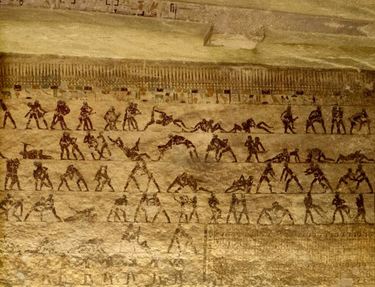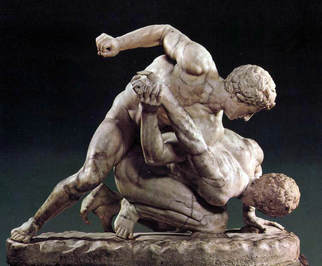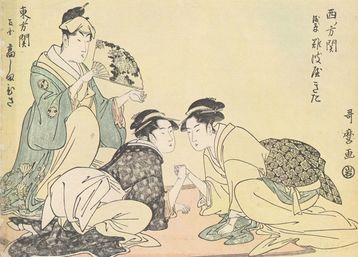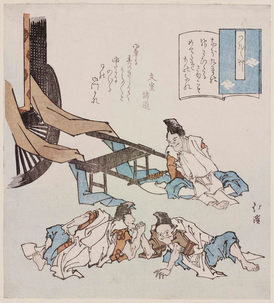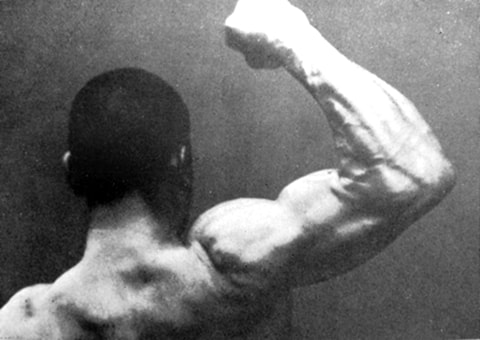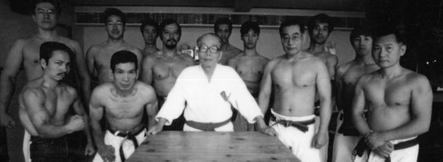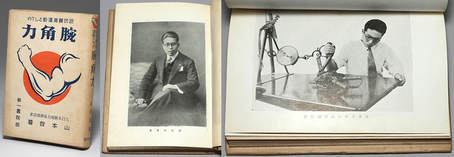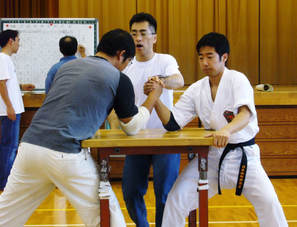Early Origins of Armwrestling
The following article was originally written in Russian by fellow armwrestling historian Oleg Stepanov. He is interested in finding out where the sport was first practiced, how it evolved, and ultimately how it spread around the world. Part of his work involves examining existing theories on where the sport originated to see I they pass muster. His work is not complete, but this article summarizes some of his findings to date.
I am very grateful that he has allowed me to translate his work and publish it on the Armwrestling Archives.
Egypt
Most articles on the early history of armwrestling mention that the sport was practiced at least as far back as ancient Egypt, and that there are hieroglyphs that back up this claim. The first purported evidence is a complex of 39 ancient tombs in a cemetery site called Beni Hasan. Beni Hasan is a grandiose structure located about 20 kilometres south of Mynia, in Middle Egypt. It contains several painted rooms that have been preserved due to Africa’s dry climate. The tomb of Baqet III (21st century BC) is now referred to as the "Fight Hall", as its walls are painted with figures of fighters.
In her article "Luta de Braço", Ana Miragaya, a Brazilian professor of physical education, writes:
... The opening of the tombs of the Middle Kingdom (2000 BC), located in Egypt at a distance of three kilometers from the city of Mynia, in the ancient city of "Menate Khufu”, a dynasty of the times of Oryx nome, provided at our disposal scenes of ancient Egyptian life, where among other types of combat, given in the form of wall drawings, there are images of people competing in arm wrestling ...
Alas, amidst the frescoes of the walls of Beni Hasan, I could not find a single armwrestler. There are drawings where two men face each other with their elbows bent, but another picture nearby explains that this is just a drawing of a grip in a standing fight.
Here is another photo from the same hall. In particular, look at the fifth pair on the left in the upper row:
Here is another room: the tomb of Amenemhat (approximately 1938-1913 BC). It contains three walls. Everything is presented in the form of drawings, so that it can be seen more clearly.
Spanish is very close to the Portuguese and their texts on ancient Egypt are very close to those of Ana Miragaya. The Spaniards even attached a specific list of tombs in which you can find depictions of people engaged in armwrestling: Amenemhat or Ameny n ° 2, Khen Hotep n ° 3, Bakht 3 n ° 15, Khety 3 n ° 17.
As you can see, interpreting these drawings as “armwrestling” is a bit of a stretch.
There may be other evidence. Here is another picture:
In interpreting Egyptian hieroglyphs, it is important to consider a particular detail. Artists did not like to depict people from the back. Such drawings can be found, but they are quite rare. Drawings typically depicted hands from only one side. So if one person faced another and they grasped hands in an armwrestling-like position, it would look like a right hand would be clasping a left hand. So one can assume that the hands in this drawing are both right hands (or both left hands). But, the competitors are wrestling standing up, and their elbows aren’t supported. To leap to the conclusion that this was an early form of armwrestling may be a bit much, especially when you consider that they competed standing with crossed legs! Take a look at the full image:
The bas-relief below is taken from the tomb of Mereruka in Saqqara. The tomb consists of a long hall with four square columns, and an eastern wall. "Armwrestlers" can supposedly be found in the bottom row. Unfortunately the barrels are not painted, so everything is gray. To get a better view of the details, here is a close-up of the two lower rows:
As you can see, this is just a dance. Here, you can see the full image of the wall:
On the left are six spectators who are clapping their hands. The second row from the bottom is also a dance. Only, it is a group dance with girls holding their hands over their heads. And on the left, there are also clapping spectators. And all of this action is called the Muu ritual dance.
Here is yet another depiction of supposed “armwrestlers” from a different location, but in good condition. See how they cross their legs. Dr. Thierry Benderitter, of the International Association of Egyptologists, has described this as a ritual dance where partners stand on one leg, squeeze their hand into a fist, and press their fists against each other’s.
It is important to note that in the above text you will not find the statement that armwrestling was not practiced in ancient Egypt. I’ve simply presented you with the information available on the popular theories about the sport’s existence in the land of the pharaohs. I don’t know whether armwrestling existed in ancient Egypt or not – but I do not consider the purported evidence to be valid proof.
Greece and Rome
Other places that are recognized by some as the birthplace of armwrestling include Greece and Rome. Allegedly, ceramic fragments were found that depict people engaged in armwrestling. Let's see what armwrestling-related activities could have been practiced in these ancient times by examining the artifacts that are in historians’ hands.
For those who do not know, Ancient Greece spanned a long period of history. And in different places and at different times, completely different kinds of competitions were popular. Wrestling-style competitions were common and initially quite brutal. Eventually, certain rules were developed to eliminate much of the brutality, which offered more prolonged combat to entertain spectators.
For those who do not know, Ancient Greece spanned a long period of history. And in different places and at different times, completely different kinds of competitions were popular. Wrestling-style competitions were common and initially quite brutal. Eventually, certain rules were developed to eliminate much of the brutality, which offered more prolonged combat to entertain spectators.
There is an opinion that the feet and legs were originally used in stand-up wrestling in Ancient Greece, but eventually wrestling evolved to where it was forbidden to grab anything from below the waist and it was forbidden to use one’s legs to grab an opponent. That is, it was wrestling where only the hands were used. In the above bas-relief, you can see how one of the judges uses a stick to prevent a wrestler from using his feet.
Among other things, there was a type of wrestling with fingers called "acrocheirismos". Some historians argue that this was a special kind of wrestling, while others say that it is just a tactic used in regular stand-up wrestling. That is, the wrestlers learned to grab their opponent’s fingers with such force that it would twist them and make them fall to the ground. Mastering this skill was seen to be very impressive, because it allowed someone to win before even really starting to fight. Leontiskos from Messene was so good at this, that he used the technique to win two championships at the Olympics!
There is more. When speaking of armwrestling in ancient Greece, we should not forget such entertainment as "helkustinda" or "efelkustinda", the sport that is now known as tug of war. And according to the texts of Julius Pollux (2nd century AD), there was also a "dielkustinda", in which everything was the same, but without a rope. That is, competitors simply grabbed their opponent's hand and pulled it towards themselves. In this sense, it could be considering a form of “wrestling with arms”.
The word "acrocheirismos" was used by Hippocrates in his scientific works to denote the amputation of fingers. The same word and the same expression at different times had completely different meanings. I mention this because it is important to understand that “wrestling with arms” in these historical contexts does not necessarily mean “arm wrestling” in the form that we now know.
Once again, I am not claiming that armwrestling was not practiced in Greece or Rome. I am simply saying that the available facts are not sufficient to argue that it was. If there are new facts, I will be glad to consider them. If someone "keeps a fig in their pocket", that is, has evidence but hides it, that's his business. But for now, the fact is that in almost all short or complete historical studies on the subject of armwrestling there is no concrete proof of its existence in either Greece or Rome.
Japan
As I’ve written above, I did not find any material evidence of the existence of this sport in Egypt, Greece or the Roman Empire. In Japan, however, there are hundreds of specific documents, which clearly show that armwrestling has existed there for many years.
To begin with, I must make a few comments about the Japanese language. Armwrestling is called "udezumo" in Japanese. For those who are not aware, what we call "sumo", in Japanese sounds like "zumo". That is, this Japanese word consists of two words: “ude” (“hand” (more precisely - forearm)) and “zumo”. However, this is not to say that the sport should be translated as "hand-sumo." Also, "sumo” is not the name of a sport in which very big men push each other. The Japanese word "sumo" simply means "fight". Thus, the Japanese word "udezumo" should be translated simply as "fighting with the hands".
The very first reference to armwrestling can be found in an early Japanese written source from the year 712 titled “Kojiki”, in which the gods Takemikazuchi (“Thunder-God”) and Takeminakata (“Brave-August-Name-Firm”) had a match for possession of the Japanese islands. The match itself was short: Takemikazuchi crushed Takeminakata’s hand, Takeminakata ran away, pleaded for his life, and then agreed to hand over the land. It had little resemblance to armwreslting as it is now known, but it is recognized as an early "fight of the hands".
Actually, arms were not the only body parts with which the Japanese wrestled. They are an inventive people: they wrestled with their feet, with their neck using a rope (kubihiki), with their fingers (yubi sumo), and even wrestling with buttocks (widthwise)!
The Japanese themselves consider that armwrestling came to them along with what later turned into karate, that is, from India and China to Okinawa and then to Japan. Training the hands was of utmost importance. In the Okinawan dialect, “hand” is pronounced "te" ("ude" is the Japanese word). The activity was sometimes called Okinawa-te, which can be translated as "The Hand of Okinawa". Returning from China, martial arts master Sakugawa (1762) called his type of fighting "Karate no Sakugawa."
From the very beginning, the Japanese began arm wrestling in the standard hand position (with thumbs locked). It had nothing to do with modern theories, which supposedly state "if you take an opponent by the palm (hand wrestling), then there is an increased danger of injury." Everything was much simpler. Fighting is a game of war. And at that time, in war the most important thing was the ability to work with a sword. Hand strength and dexterity was critically important, so training was focussed on the hand maintaining this position. Speed was also incredibly important – in Japanese culture you can find many tales about how skilful warriors specially cut off one or two fingers, just to make it easier to twist their swords.
You may have seen in a movie two masters hit each other’s swords and freeze in a strained pose – each trying to overpower the other (think Star Wars and light-sabers). To train for this particular skill, the Japanese used to armwrestle. It was thought that if you could overpower your opponent in an armwrestling match, you could overpower him in a sword fight. They wrestled lying down, standing on tufts, and at the dinner table.
In 1853, Commodore Matthew Perry and the US Navy arrived on the shores of Japan to force the opening of Japanese ports to American trade. Though there was initial resistance, under the threat of the outbreak of war, Japan had little choice but to sign the Convention of Kanagawa, which ended a near 250-year policy of national seclusion. In opening up trade between the two countries, the Japanese became increasingly exposed to the ways of the west and by the beginning of the 20th century began to copy foreign structures for the organization of communities and to engage in non-traditional sports. In March 1928, in the city of Yokohama, Tetsu (Satoshi) Yamamoto created the first Japanese arm wrestling association, which was named "The Yokohama Hand" (remember the "hand of Okinawa"). A few years later in 1934, the "Great Japanese Association of Armwrestling" was established.
Tetsu Yamamoto was born at the very beginning of the 20th century and died at the age of 102 in 2002. Up to the age of 85 he worked as a dentist. He was the creator of the first association, a philosopher, a teacher and the spirit of Japanese armwrestling. He was given the humble title of "God of Armwrestling".
In 1998, a film was shot for Japanese television titled "Armwrestling, a 98 year old undefeated man against professional wrestler Manabu Nakanishi" at the end of which he shared his techniques.
In 1938, Yamamoto wrote his first book on the sport, and exactly 40 years later, in 1978, his second.
The first “sport arm-wrestlers” of that time were closely connected with bodybuilders. Now it is difficult to understand, but at the time this was frowned upon by orthodox Japanese. Bodybuilding was the sport of the Americans, and the "sport arm-wrestlers" used "American tables" (with longer legs than those of the classic Japanese dining tables), which was considered a sin. Nevertheless, this kinship has helped considerably in the development of devices for specific training, in which the American version of the sport has grown.
After moving to a square table, opponents began to hold the corners of the table with their free hands and the match itself took place diagonally. As before, a thumb-lock grip was used. Some time later, elbow pain prompted a decision to allow competitors to wear an elbow sleeve on their competing arms to allow for a bit of protective cushioning.
Historically, during the competitions the Japanese used a round robin format, where all competitors within a division pulled each other. If you look at the last photo, you will see in the background judges keeping track of tournament results. In Japan, wins are denoted by a circle, and losses by a cross. (By the way, the modern game of "tic-tac-toe" was derived from this). Naturally, from the very beginning, a classification was developed in the form of "dan" for masters and "kyu" for beginners, and a competitor’s level was identified by the colour of his belt.
The structure was gaining momentum and the association had many different divisions. In 1940, the first major all-Japanese tournament was held. In April 1953, the name was changed to the “Japan Arm Sumo Association”.
Unfortunately, self-reliance and the desire for national independence did not last long. To participate in the "American" tournaments, in 1977 Mitsuo Endo, famous Japanese bodybuilder and president of the Japanese Powerlifting Federation, created the Japanese Armwrestling Association (JAWA). It is this association that now represents Japan in the world, it is the winners of the JAWA tournaments that go to the world championships and it is JAWA that is a member of the World Armwrestling Federation.
The two organizations continue to co-exist to this day.
Researched and Originally Written in Russian by Oleg Stepanov.
Translated and Adapted by Eric Roussin.
For more information on the sport of arm sumo, you can visit the association’s website.
